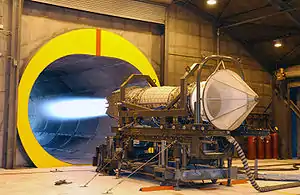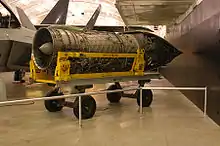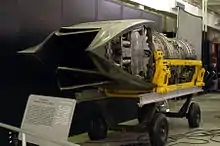Pratt & Whitney F119
The Pratt & Whitney F119, company designation PW5000,[1] is an afterburning turbofan engine developed by Pratt & Whitney for the Lockheed Martin F-22 Raptor advanced tactical fighter.
| F119 | |
|---|---|
 | |
| F119 engine on test | |
| Type | Turbofan |
| National origin | United States |
| Manufacturer | Pratt & Whitney |
| Major applications | F-22 Raptor |
| Number built | 507 |
| Developed into | Pratt & Whitney F135 |
The engine delivers thrust in the 35,000 lbf (156 kN) class, and is designed for supercruise. Delivering almost 22% more thrust with 40% fewer parts than its F100 predecessor, the F119 allows sustained supercruise speeds of up to Mach 1.8.[2][3] The F119's nozzles incorporate 2D thrust vectoring technology that enable them to direct the engine thrust ±20° in the pitch axis to give the F-22 enhanced maneuverability.
The F119 derivative, the Pratt & Whitney F135, produces up to 43,000 lbf (190 kN) of thrust for the Lockheed Martin F-35 Lightning II.[4]
History
The F119 resulted from the Joint Advanced Fighter Engine (JAFE) program in the early 1980s aimed at supplying the powerplant for the Air Force's Advanced Tactical Fighter (ATF). Detailed design of Pratt & Whitney's submission, designated internally as PW5000, began when the JAFE request for proposals (RFP) was released in May 1983. Advances in engine technology, such as those from the Integrated High Performance Turbine Engine Technology (IHPTET) program, allowed the design to do more work with fewer stages, with the PW5000 having only 6 compressor stages compared to the F100's 10 compressor stages. The high pressure and low pressure turbines were single stage and counter-rotating, thus shortening the engine by removing a row of stators and saving weight. The fan and compressor stages were to use integrally bladed rotors (IBR) to reduce weight and cost and improve performance. The combustor, designated Floatwall, eliminates welds to mitigate crack growth due to thermal cycling. This technology allows the engine to achieve very high core temperatures to meet the requirement for high specific thrust for supercruising. The original RFP called for maximum thrust in the 30,000 lbf (133 kN) class.[5]
Pratt & Whitney and General Electric were selected to make prototype engines, designated YF119 and YF120 respectively, for demonstration and validation. The ATF's increasing weight required more thrust to meet the performance requirements, and required max thrust increased by 20% to 35,000 lbf (156 kN) class. Pratt & Whitney's design changed to incorporate a 15% larger fan, increasing bypass ratio from 0.25 to 0.30. However, unlike General Electric, Pratt & Whitney did not fit its larger fan on flightworthy YF119s for the ATF flight demonstrators to avoid potential reliability issues that may arise. Instead, the revised fan was extensively ground tested at Wright-Patterson Air Force Base. As a result, both the YF-22 and YF-23 had lower performance with the YF119s than with the YF120s.[6]
On 3 August 1991, Pratt & Whitney was awarded the EMD contract for ATF engine, while the Lockheed/Boeing/General Dynamics team won the contract for the ATF airframe. While the YF119 was a more conventional design compared to the General Electric's variable cycle YF120, Pratt & Whitney accrued far greater test hours and emphasized the lower risk. The production F119-PW-100 was fitted on the production F-22A.[7]
Design
The F119 is a twin-spool axial-flow low-bypass turbofan. It has a three-stage fan driven by a single-stage low pressure turbine and six-stage high pressure compressor driven by single-stage high pressure turbine. The shroud-less fan has wide-chord, low aspect ratio hollow titanium fan blades that are linear-friction welded to the disks to form single-piece blisks. The compressor stators and thrust-vectoring nozzle use burn-resistant titanium alloy called Alloy C, with the first row of stators variable in order to increase surge margin. The Floatwall annular combustor ensures the clean burning of the fuel and reduced NOx generation. The high-pressure turbine blades are made of single-crystal superalloys and impingement cooled using air from the high-pressure compressor. The two spools are counter-rotating, which results in weight savings due to the elimination of a row of stators. The requirement for the ATF to supercruise, or fly supersonic without afterburners, results in a very low bypass ratio of 0.3 for the F119-PW-100 in order to achieve high specific thrust. The F119 has dual-redundant full authority digital engine control (FADEC).[8]
The three-zone afterburner, or augmentor, contributes to the stealth of the aircraft by having fuel injectors integrated into thick curved vanes coated with ceramic radar-absorbent materials (RAM). These vanes replace the traditional fuel spray bars and flame holders and block line-of-sight of the turbines. The nozzle can vector ±20° in the pitch axis to improve aircraft maneuverability and consists two wedge-shaped flaps for stealth. The nozzles also contribute to lower infrared (IR) signature by flattening the exhaust plume and facilitating its mixing with ambient air through shed vortices.[9] The engine has a design life of 8,650 total accumulated cycles.[10]
Operational history
Ground tests of the F119-PW-100 were first conducted in February 1993. The engines were first flown on the F-22's maiden flight on 7 September 1997. A total of 507 engines were produced.[11]
In 2013 Pratt assisted the F119 Heavy Maintenance Center (HMC) at Tinker Air Force Base, Oklahoma in the first depot overhaul of an F119 engine.[12]
Variants
- YF119-PW-100L: Prototype engine for the YF-22; rated 30,000 lbf thrust class.
- YF119-PW-100N: Prototype engine for the YF-23; rated 30,000 lbf thrust class.
- F119-PW-100: Production engine for the F-22A with larger fan and increased bypass ratio (BPR) rated for 35,000 lbf thrust class.
- YF119-PW-611: Prototype engine for the X-35.
- YF119-PW-614: Prototype engine for the X-32.
Applications
- Boeing X-32 (YF119-PW-614)
- Lockheed YF-22 (YF119-PW-100L)
- Lockheed Martin F-22 Raptor (F119-PW-100)
- Lockheed Martin X-35 (YF119-PW-611)
- Northrop YF-23 (YF119-PW-100N)
Specifications (F119-PW-100)


Data from Pratt & Whitney,[13] National Museum of the US Air Force,[14] RAND,[15] Aviation Week,[16] USAF.[17]
General characteristics
- Type: Twin-spool, axial-flow augmented turbofan
- Length: 16 ft 11 in (516 cm)
- Diameter: Approx. 46 in (120 cm)
- Dry weight: 3,900 lb (1,800 kg)
Components
- Compressor: 3-stage fan, 6-stage high-pressure compressor
- Bypass ratio: 0.30:1
- Combustors: Annular combustor
- Turbine: 1-stage high-pressure, 1-stage low-pressure counterrotating turbines
- Nozzle: 2-dimensional vectoring convergent-divergent
Performance
- Maximum thrust:
- 26,000 lbf (116 kN) (military thrust)
- >35,000 lbf (156 kN) (with afterburner)[N 1][18]
- Thrust-to-weight ratio: 6.7:1 (dry), 9.0:1 (afterburning)
See also
Related development
Comparable engines
Related lists
References
- Actual thrust is in the 37,000–39,000 lbf (164.6–173.5 kN) range
- "Designations Of U.S. Military Aero Engines". www.designation-systems.net. Retrieved 16 April 2018.
- F-22 Flight Test Data Archived 2006-06-18 at the Wayback Machine. accessed August 8, 2007.
- Last of its kind. Flightglobal.
- "F-35 Joint Strike Fighter Media Kit Statistics (ZIP, 98.2 KB)". jsf.mil. Archived from the original on 26 June 2019. Retrieved 16 April 2018.
- Aronstein pp. 211–215
- Aronstein pp. 221–222
- Aronstein pp. 227
- "Pratt & Whitney F119". Forecast International.
- Katz, Dan (7 July 2017). The Physics And Techniques Of Infrared Stealth. Aviation Week. Retrieved 12 April 2019.
- "Pratt & Whitney's F119 Demonstrates Full Life Capability". Pratt & Whitney. 10 September 2010. Retrieved 12 May 2019.
- Majumdar, Dave (17 January 2013). "Pratt & Whitney to deliver last F-22 Raptor engine".
- PRNewswire. "Pratt & Whitney, U.S. Air Force Complete First Depot Overhaul of an F119 Engine". providencejournal.com. Retrieved 16 April 2018.
- "F119 Engine". Pratt & Whitney. Archived from the original on 2014-07-21. Retrieved 2012-11-28.
- "Factsheets : Pratt & Whitney YF119-PW-100L Augmented Turbofan". archive.org. 14 December 2014. Retrieved 16 April 2018.
- Military Jet Engine Acquisition, RAND, 2002.
- Bill Sweetman (3 November 2014). "J-20 Stealth Fighter Design Balances Speed And Agility". Aviation Week & Space Technology. Retrieved 8 November 2014
- F-22 Raptor fact sheet. USAF, March 2009.
- AIR International, July 2015, p. 63
- Aronstein, David C.; Hirschberg, Michael J. (1998). Advanced Tactical Fighter to F-22 Raptor: Origins of the 21st Century Air Dominance Fighter. Arlington, Virginia: American Institute of Aeronautics & Astronautics. ISBN 978-1-56347-282-4.
External links
| Wikimedia Commons has media related to Pratt & Whitney F119. |